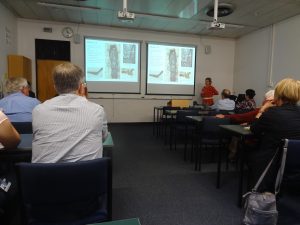Professor Hallie Buckley’s seminar on the Milton cemetery
The Centre for Global Migrations and Department of History and Art History recently hosted a research seminar from Professor Hallie Buckley from the Department of Anatomy at the University of Otago. Drawing on findings from a research team of bioarchaeologists and archaeologists, the talk focused on a below-ground analysis of the St John’s cemetery at Milton, Otago, where from 200 plots only 7 are identifiable from headstones. With documentary analysis, however, local researchers have managed to identify the names of 75 folk buried there.
Professor Buckley’s team has excavated 25 graves containing 27 skeletons and the talk showcased methodologies to identify the unmarked burials through analysis of bones, teeth and DNA. Isotope analysis of teeth, for instance, can reveal an individual’s place of birth, what their diet was like as children and adults. Physiological stress can be assessed through the bones and teeth and whether they were pipe smokers. The skeletons can further be checked for Vitamin D deficiency, which may have led many early migrants to be vulnerable to other diseases such as tuberculosis. Analysis of the skeletons can also be matched to newspaper accounts of the ways people died. For instance, one press report revealed a death in Milton due to rockfall with one of the skeletons showing the physical signs of such a life-ending accident.

As well as aiding the local Milton community, Professor Buckley hopes the project will enable us to learn more about the biology of goldminers and whether identifying the presence of tuberculosis in the past can help with treatment today.

